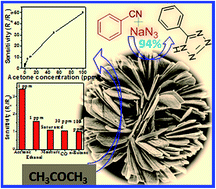Rectangular ZnO porous nano-plate assembly with excellent acetone sensing performance and catalytic activity†
Abstract
The controlled synthesis of a hierarchically assembled porous rectangular ZnO plate (2.5–3.5 μm length, 1.5–2.5 μm width and 100–150 nm thickness) from bulk ZnO without using any organic substrates, such as solvents/surfactants/structure-directing agents, is presented. The synthesized ZnO plates are single crystalline with exposed (10![[1 with combining macron]](https://www.rsc.org/images/entities/char_0031_0304.gif) 0) facets on the flat surface, porous and formed through the calcination of a hydrozincite [Zn5(CO3)2(OH)6] intermediate. A gas sensor based on the synthesized porous ZnO architecture exhibited high sensitivity towards acetone even in low concentration (S = 3.4 in 1 ppm acetone) with good selectivity. The ZnO nanostructured material as a heterogeneous catalyst also showed excellent catalytic activity for the synthesis of 5-substituted-1H-tetrazoles (yield = 94%). Both the activities are superior than those of other reported ZnO based acetone sensors and heterogeneous catalysts. We believe that the improved properties of the synthesized ZnO nanostructure is due to the exposed (10
0) facets on the flat surface, porous and formed through the calcination of a hydrozincite [Zn5(CO3)2(OH)6] intermediate. A gas sensor based on the synthesized porous ZnO architecture exhibited high sensitivity towards acetone even in low concentration (S = 3.4 in 1 ppm acetone) with good selectivity. The ZnO nanostructured material as a heterogeneous catalyst also showed excellent catalytic activity for the synthesis of 5-substituted-1H-tetrazoles (yield = 94%). Both the activities are superior than those of other reported ZnO based acetone sensors and heterogeneous catalysts. We believe that the improved properties of the synthesized ZnO nanostructure is due to the exposed (10![[1 with combining macron]](https://www.rsc.org/images/entities/char_0031_0304.gif) 0) facets, and its porous and assembled structure, which provides a reasonably large accessible surface area, and facilitates diffusion and mass transport of gas or substrate molecules.
0) facets, and its porous and assembled structure, which provides a reasonably large accessible surface area, and facilitates diffusion and mass transport of gas or substrate molecules.


 Please wait while we load your content...
Please wait while we load your content...